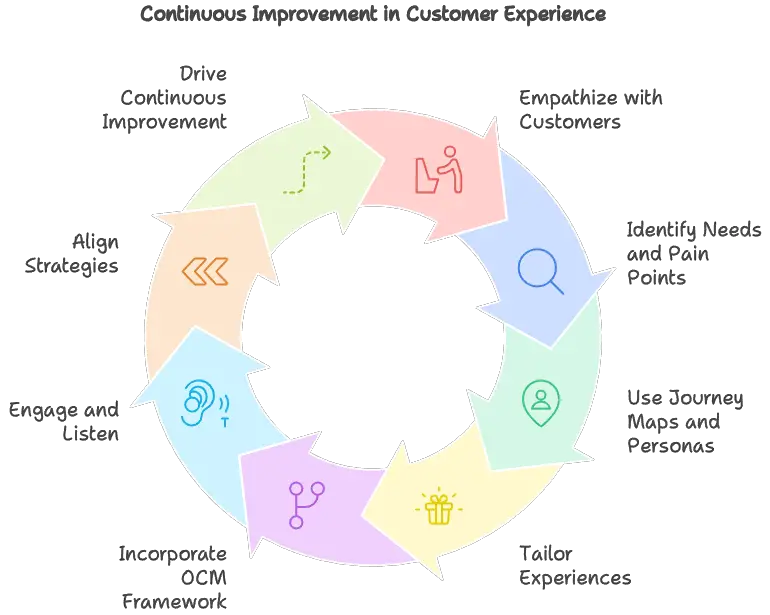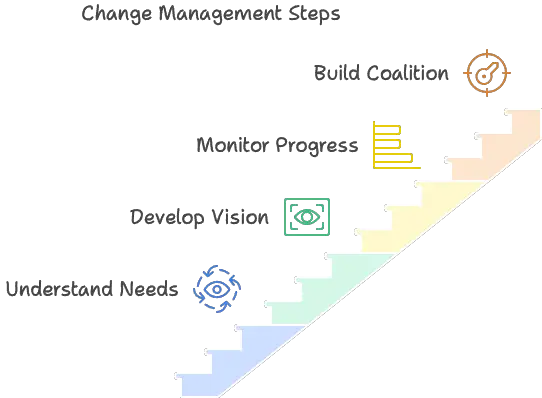You may be surprised to learn that according to a recent study, 70% of organizational change initiatives fail to meet their objectives. Understanding how change management can significantly impact customer experience enhancement is crucial for your organization’s success.
By focusing on aligning strategies with customer needs, fostering collaboration across departments, and implementing effective change initiatives, you can set the stage for transformative improvements.
But what are the key strategies that can help you navigate these challenges successfully and drive lasting results? Let’s explore together.
Key Takeaways
- Understand customer needs through journey maps and personas
- Develop a clear change vision with stakeholder engagement
- Monitor progress using data analytics and competitor analysis
- Build a guiding coalition for implementing effective change initiatives
Understanding Customer Needs
To improve customer experiences effectively, you must deeply empathize with various customer types to uncover their needs and pain points. Understanding customer needs is foundational in any change management framework aimed at enhancing customer experiences.
By utilizing journey maps and personas, companies can gain valuable insights into the diverse requirements of their customers, enabling them to tailor experiences accordingly. Placing yourself in the customers’ shoes allows for the identification of pain points and areas for improvement throughout the customer journey.

Incorporating an organizational change management (OCM) framework can facilitate discussions focused on improving engagements and meeting customer needs more effectively.
In industries like aviation, effective listening and engagement play a pivotal role, as trust and understanding customer needs are fundamental for successful customer experience (CX) strategies. By embracing empathy and utilizing tools like journey maps, companies can align their strategies with the ever-evolving requirements of their customers, driving continuous improvement in the overall CX landscape.
Aligning Departments for Buy-In
To effectively align departments for buy-in, focus on fostering team collaboration benefits and implementing departmental communication strategies.

By breaking down barriers and promoting cross-functional cooperation, you can ensure that all stakeholders are invested in the customer experience improvement process.
Creating a shared understanding and vision across departments is crucial in gaining support and driving successful change management initiatives.
Team Collaboration Benefits
By aligning departments for buy-in, organizations can foster a culture of collaboration that enhances their approach to improving customer experience.
Breaking down silos and aligning stakeholders ensures a more cohesive strategy for customer experience enhancement.
It is crucial to gain buy-in from the C-suite to drive successful change management initiatives focused on customer satisfaction.
Reinforcing touchpoints across departments unifies the focus on customer experience, leading to streamlined processes. Consistent understanding and vision among departments streamline operations and enhance overall customer satisfaction.
| Benefits of Team Collaboration | Impact on Customer Experience |
|---|---|
| Enhanced communication | Improved customer satisfaction |
| Increased efficiency | Consistent customer experience |
| Shared goals and vision | Streamlined processes |
Departmental Communication Strategies
Implementing consistent and targeted communication strategies across departments is crucial for aligning stakeholders and fostering a unified approach towards improving customer experience. To achieve this alignment and buy-in from internal stakeholders, consider the following strategies:
- Develop a Comprehensive Communications Plan: Create a detailed plan that outlines the communication channels, key messages, and frequency of updates to ensure all departments are informed and engaged.
- Engage Internal Stakeholders: Involve key stakeholders from various departments in the communication planning process to gather insights, address concerns, and tailor messages to resonate with different teams.
- Align Departmental Goals with Overall Vision: Connect departmental objectives with the overarching goal of enhancing customer experience to ensure everyone is working towards a common purpose.
Developing Change Vision Effectively
Crafting a clear change vision is crucial to provide employees with a roadmap for decision-making during times of transformation.
Aligning this vision with your brand’s purpose and customer expectations can effectively propel customer experience improvements forward.
Engaging key stakeholders and communicating the purpose of change are essential steps in ensuring successful implementation and long-term success in driving customer experience enhancements.
Clear Change Objectives
To effectively develop clear change objectives for enhancing customer experience, it’s crucial to align stakeholders, break down organizational silos, and secure leadership buy-in.
When crafting change objectives in the transformation process, consider the following key points:
- Stakeholder Alignment: Ensuring that all parties involved understand and support the change objectives is essential for a smooth transition.
- Organizational Silos: Breaking down barriers between departments promotes collaboration and allows for a cohesive approach towards improving customer experiences.
- Leadership Buy-In: Securing the commitment of top management is vital in driving the necessary resources and support for successful implementation of change objectives.
Engage Key Stakeholders
Aligning key stakeholders with a clear change vision is essential for effectively driving customer experience improvement initiatives within an organization.
By engaging stakeholders in the development of a clear roadmap for change, you ensure that enhancements and investments are strategically aligned to boost customer experience.
Take a look below to understand the key steps in engaging stakeholders to drive change vision effectively:
| Key Steps to Engage Stakeholders |
|---|
| Establish a clear change vision aligned with the organization’s brand purpose |
| Develop a roadmap for change with targeted enhancements |
| Gain buy-in from C-suite executives for consistent understanding |
| Break down silos and reinforce touchpoints across departments |
| Craft a comprehensive communication plan for empathy and understanding |
This strategic approach will help unify stakeholders and create a shared vision for customer experience enhancement.
Communicate Change Purpose
Developing a clear and compelling change vision is pivotal for effectively communicating the purpose of change within an organization, guiding employees towards unified goals and actions.
When it comes to enhancing customer experience through change management, here are three key strategies for communicating the change purpose effectively:
- Simplify the Vision: Making necessary trade-offs to simplify the change vision ensures clarity and enhances understanding across all levels of the organization.
- Drive Organizational Alignment: Effective change visions drive organizational alignment, focus, and commitment towards achieving customer experience improvement goals.
- Empower Autonomy: A well-defined change vision empowers employees to act autonomously and align their efforts towards common customer experience improvement objectives.
Following the Golden Rule Approach
By embracing the Golden Rule Approach in change management, you can effectively enhance your customer experience strategies. This approach emphasizes treating customers how you’d like to be treated yourself, ensuring that their needs, preferences, and expectations guide your improvement initiatives.
By following this principle, you build trust, loyalty, and satisfaction among your customers. Personalizing experiences based on this approach helps create meaningful interactions and fosters long-term relationships. Customers appreciate feeling valued and understood, leading to a positive brand perception.
When you implement the Golden Rule Approach, you show empathy and consideration towards your customers, which can result in increased customer satisfaction and loyalty. By consistently applying this approach in your change management processes, you’re likely to see improvements in customer experience and overall business performance.
Monitoring Transformation Progress
To ensure the success of your change management initiatives focused on enhancing customer experience, it’s crucial to actively monitor the progress of transformation through various data-driven methods.
Here are three key strategies to effectively monitor the transformation progress:
- Utilize Customer Surveys and Feedback Analysis: Implement regular customer surveys to gather feedback on the changes made. Analyze this data to understand customer sentiments and identify areas for improvement in the customer experience.
- Leverage Data Analytics for Real-Time Insights: Use advanced analytics tools to track customer feedback in real-time. By monitoring social media, contact center data, and online reviews, you can promptly address any concerns that arise during the transformation process.
- Track Key Performance Indicators (KPIs): Establish KPIs related to customer experience improvements and monitor them closely. Evaluate the effectiveness of your change management initiatives based on these metrics to ensure that the transformation aligns with your customer experience goals.
Competitor Analysis for Insights
Analyzing your competitors’ communication strategies offers invaluable insights into areas where customer experience enhancements can be made. By conducting competitive analysis, you can identify gaps in communication that may be affecting customer satisfaction. Understanding how your competitors engage with their customers can provide a roadmap for improving your own customer experience strategies.
Competitive analysis is crucial for developing a transformation plan that keeps you ahead in the market. By evaluating your competitors’ approaches to communication, you can make informed decisions on how to better engage with your customers. Leveraging insights from competitor analysis allows you to identify best practices and areas where you can differentiate yourself in terms of customer experience.
Incorporating competitive analysis into your overall strategy can give you a competitive edge and help you stay relevant in a fast-paced market. By learning from your competitors and adapting your communication strategies, you can enhance the overall customer experience and drive business growth.
Creating a Sense of Urgency
To drive immediate action and prioritize improvements in customer experience, it’s essential to establish a compelling connection between business imperatives and the need for change. By linking customer experience to critical business issues such as customer churn and escalating costs, a sense of urgency for change can be effectively cultivated.
Here are three key strategies to create a sense of urgency in change management for customer experience improvement:
- Initiate with a Strong Call to Action: Begin change initiatives by emphasizing the impact on business needs rather than solely focusing on low survey scores. This approach resonates more with stakeholders and encourages immediate attention and action.
- Align with Business Goals: Effective change management programs align with overarching business goals and priorities. By highlighting how enhancing customer experience directly contributes to achieving these goals, the urgency for improvement becomes apparent.
- Proactive Issue Addressing: Addressing customer experience issues proactively can prevent negative consequences of a decrease in share of wallet. This proactive stance showcases the importance of timely interventions in maintaining and enhancing customer satisfaction levels.
Building a Guiding Coalition
Engaging senior leadership through a dedicated CX Council is crucial in forming a robust guiding coalition for effective change management initiatives. By establishing a CX Council involving key leaders across departments, you can ensure alignment, accountability, and active participation in driving customer experience improvements. This governance structure not only provides a platform for decision-making but also fosters a shared vision for change within the organization.
Active involvement of VPs is essential for building a strong guiding coalition in change management. Their support and commitment play a pivotal role in cascading the importance of customer experience throughout the organization. Leadership backing is vital for sustaining long-term improvements in customer experience, making it imperative to have senior executives championing the cause.
Developing a guiding coalition is essential to garner organizational support and commitment to CX transformation. This coalition acts as a driving force, steering change initiatives towards successful implementation and ensuring that customer experience remains a top priority across all levels of the organization.
Implementing Effective Change Initiatives
When implementing effective change initiatives for customer experience improvement, clarity in vision alignment with business goals and priorities is paramount. Without a clear understanding of where the organization is headed and why, it becomes challenging to drive meaningful change that enhances the customer experience.
To ensure successful implementation of change initiatives in CX change management, consider the following:
- Secure Strong Leadership Support: Leadership backing is fundamental for driving change initiatives forward. Leaders play a crucial role in setting the tone, allocating resources, and championing the importance of enhancing customer experience across the organization.
- Follow a Strategic Approach: After forming a guiding coalition and gaining executive support, it’s essential to follow a strategic approach to implementation. Develop a detailed plan that outlines the steps, timelines, responsibilities, and expected outcomes of the change initiatives.
- Focus on Continuous Learning and Improvement: Customer experience enhancement is an ongoing process. Emphasize continuous learning and improvement to drive tangible business outcomes and ensure sustained success in improving the customer experience.
Frequently Asked Questions
What Is Change Management in Cx?
Change management in CX involves strategically implementing changes to enhance customer experience. It focuses on aligning organizational processes, people, and technology to improve interactions. This approach ensures smooth transitions to new initiatives, driving satisfaction and loyalty.
What Are the 5 C’s of Change Management?
When managing change, remember the 5 C’s: Communication, Collaboration, Commitment, Creativity, and Celebration. Stakeholder engagement drives success. Clear communication planning, training development, and effective resistance management are crucial for navigating change and improving customer experience.
What Are the Five 5 Change Management Strategies?
You need to engage stakeholders and manage resistance effectively while planning communication and implementing training. These strategies are key for successful change management. Stay focused on aligning departments and gaining leadership support for optimal results.
What Are the 5 R’s of Change Management?
You must understand the 5 R’s of change management: Resonance, Readiness, Resourcefulness, Response, and Resilience. They guide you in navigating resistance and engaging stakeholders effectively. Mastering these principles will enhance your change management skills.
Conclusion
To drive successful change management for customer experience improvement, it’s essential to prioritize understanding customer needs. According to a recent study by Harvard Business Review, organizations that focus on customer-centric strategies experience a 20% increase in customer satisfaction and a 10% increase in revenue.
By aligning departments, developing a clear change vision, and implementing initiatives effectively, companies can create impactful customer experiences and achieve sustainable business growth.
Stay focused on the customer to drive positive results.





